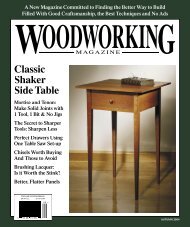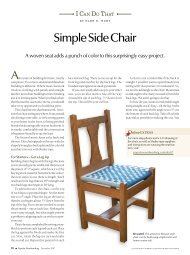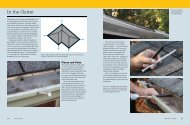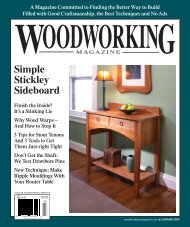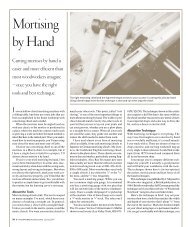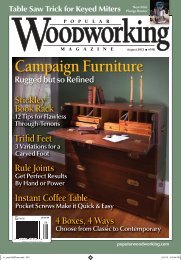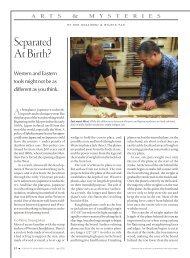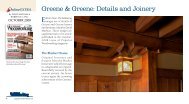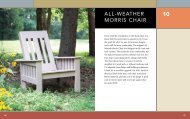January 2000 - Popular Woodworking Magazine
January 2000 - Popular Woodworking Magazine
January 2000 - Popular Woodworking Magazine
You also want an ePaper? Increase the reach of your titles
YUMPU automatically turns print PDFs into web optimized ePapers that Google loves.
CONTEMPORARYShelvesThis simple plywood unitwould look at home in aSoHo loft or suburban greatroom. Special knockdown hardwaremakes it a snap to build.It’s rare that bookshelves look as interesting as the objects you displayon them. After all, how much can you decorate the edges of yourshelves and sides? This unit is unusual because the shelves and sidesare beefier than you would normally see, and the two bevel cuts onthe front edges give these shelves nice visual interest.Best of all, perhaps, is that this piece is simple and quick to build.Photo by Al ParrishDividers and ShelvesStart by cutting out the sides and shelves. The 1 1 ⁄ 2"-thick sides aremade by gluing two pieces of 3 ⁄ 4"-thick plywood together. The 1 1 ⁄ 4"-thick shelves are made by gluing 3 ⁄ 4"-thick plywood to a 1 ⁄ 2"-thickpiece. Note that the finished sides have a 3 ⁄ 4" x 1 ⁄ 4" rabbet for the backthat’s formed by gluing a narrower piece to a wider one. The adjustableand fixed shelves in the side openings are all the same width. The centershelves are 1 ⁄ 4" wider to account for the lack of a back.To cut the sides, crosscut a whole sheet of plywood to the lengthof the sides first, then rip them to width (11" and 11 1 ⁄ 4"). Cut the sidesa little wide ( 1 ⁄ 16"), initially, to give yourself a little room to saw off asquare straight edge. This will give you a clean edge for attaching apiece of maple later. Now nail and glue the dividers together, rememberingto offset the back edge for the rabbet. Place your nails sothe shelves will hide them.Here’s an easy way to cut the shelves. Rip them to width from aBy Jim Stuard
Face-Glue the PartsOnce you’ve got your parts cut to size, glue andnail them together leaving the rabbet at theback. Set and putty the nails, then rip thedividers to their final width.full piece of plywood, then nail and glueup a length of shelving. Then crosscutthe shelves to length from the long pieces.You can get five 16" shelves out of a 96"rip. For even less work, cut the shelves tolength after attaching the edging.Edges and AnglesThe edges for the bookshelves are solidmaple. Because the thickness of 3 ⁄ 4" and1 ⁄ 2" plywood is considered “nominal,” youwill end up with finished thicknesses about1 ⁄ 16" less. Rip your edging stock a little wideand attach it with biscuits and glue. Witha flush-cut bearing bit in a router, trim theedging flush to the sides and shelves, thenclean up your work with a plane or scraper.The last step is to bevel the edging. Thephoto shows how I did this on the tablesaw. Remember that the setup must changefor the different width pieces.the side and center sections so the shelfheights will match across the bookcase.Now it’s time for all the parts come together.Begin by assembling the two outsideunits of the bookcase. Tip them ontotheir backs and attach the aprons to thebottom shelf using cleats and screws. Nextattach the side units together forming thecenter section. The best way to do this is toassemble with the front facing up. Use a4"1 1 /4"Making it a Stand-Up UnitThe next step is to mill stopped groovesin the topmost and bottommost shelvesto accept the tapered sliding connectorsthat attach the sides together. The groovesin the ends of the shelves are 3 ⁄ 4" wide byapproximately 3 ⁄ 8" deep, and milled witha dado set on the table saw. It helps to makea practice joint because the depth of thegroove is critical to a snug fit using thisstyle of connector.After cutting the slots in the shelves,lay out and mount the small part of the taperedconnector to the side. The large connectorwill mount to the shelf groove withthe wide end towards the shelf front. Doa test fit on the shelves. The shelves in theside units should be flush to the rabbetin the back edge of the sides. The centershelves should be flush with the back.The next step is to cut the stoppedgrooves in the rest of the shelves for thehidden wire shelf supports. If your blade istoo narrow, take two cuts to get the 1 ⁄ 8"groove necessary to slide the shelf ontothe wire supports. Some drill and chiselwork will be necessary to lengthen the kerfto accept the entire 9 3 ⁄ 4" length of the shelfwire. This requires drilling and chisellinginto the end of the front edge. Lay out anddrill the locations for the wire supports in1 1 /2"Elevation16" 1 1 /2" 16" 1 1 /2" 16" 1 1 /2"54"17 7 /16"1 1 /4"17 7 /16"1 1 /4"17 7 /16"1 1 /4"17 7 /16"1 1 /4"4"84"
ProfileThe bevels on theedges are basically a“V” shape on theentire edge. See thediagram at right forthe details andcutting angles. Cleanup your saw markswith a plane.Plywood shelflaminationSolidmaple3/8"Plywoodsidelamination31°3/4"Solidmaple27°5/8"1 1 /4"5/8"3/8"3/4"1 1 /2"3/4"3/8"3/4"3/8"Detail of bevel profilesgroovefront ofthe shelf4"1 1 /4"17 7 /16"backrabbetsideshelf wire1 5 /8"1/4" 10 1 /8"12"Profile1 1 /4"1 1 /4"17 7 /16"1 1 /4"4"3/4"7/8"1 1 /4"17 7 /16"17 7 /16"84"Mount Knockdown HardwareUse a dado stack to cut a 3 ⁄ 4" x 3 ⁄ 8" groove fromthe joint where the edge attaches to the shelf tothe back of the shelf. The knockdown hardwareis mounted in about the middle of the shelf. Itpulls together pretty tightly, so you might want tosand any bumps or ridges off the ends of theshelves to keep from scratching the sides.handscrew clamp to hold up the sides whileyou’re assembling. The apron on the centerbottom can be screwed onto the shelfand braced with corner blocks prior to assembly.Push the lower shelf into place andmark the location of the apron, also calledSchedule of Materials• Contemporary ShelvesNo. Item Dimensions T W L Material4 Sides 3 ⁄ 4" x 11 1 ⁄ 4" x 84" Plywood4 Sides⁄ 4" x 11" x 84" Plywood10 Outr. shelf tops3 ⁄ 4" x 10 1 ⁄ 8" x 16" Plywood10 Outr. shelf bottoms1 ⁄ 2" x 10 1 ⁄ 8" x 16" Plywood5 Cntr. shelf tops3 ⁄ 4" x 10 3 ⁄ 8" x 16" Plywood5 Cntr. shelf bottoms1 ⁄ 2" x 10 3 ⁄ 8" x 16" Plywood2 Backs⁄ 4" x 17 1 ⁄ 2" x 76" Plywood3 Aprons⁄ 4" x 4" x 16" Plywood4 Side edging3 ⁄ 4" x 1 1 ⁄ 2" x 84" Maple15 Shelf edging3 ⁄ 4" x 1 1 ⁄ 4" x 16" MapleSupplies: Woodworkers’ Supply (800-645-9292), 12 6"taper connectors, # 928273 $4.95/pkg. of four. 18 wire shelfsupports, # 826028, $1.45 apiece for 10+.Magic WireAfter cutting the 1 ⁄ 8" grooves in the shelf sides,assemble the case. Tap the wire shelf supportsin and slide the loose shelves in place.a “kick” or a base. Then remove the shelfand add two stop blocks to the sides to supportthe center apron from behind.When you’re happy with the fit ofthe parts, disassemble the bookcase andfinish. I applied a coat of light stain to givethe maple an aged appearance. (Iused about two ounces of linseedoil and colored it with Olympicstains, one-half Early American#41552, and one-half Red Oak#41567. 1 ⁄ 4 teaspoon of each.)Wipe on an even coat of oil. Wipeoff the excess and let it dry for 24hours.The next day, lightly sandthe surfaces and clean them witha tack rag. Finish with two or threecoats of a clear finish. PW



